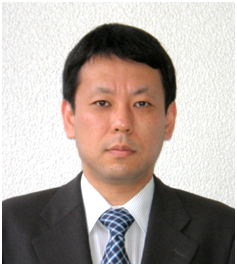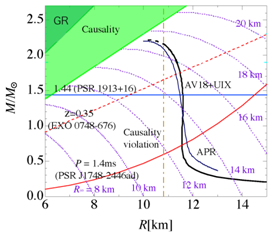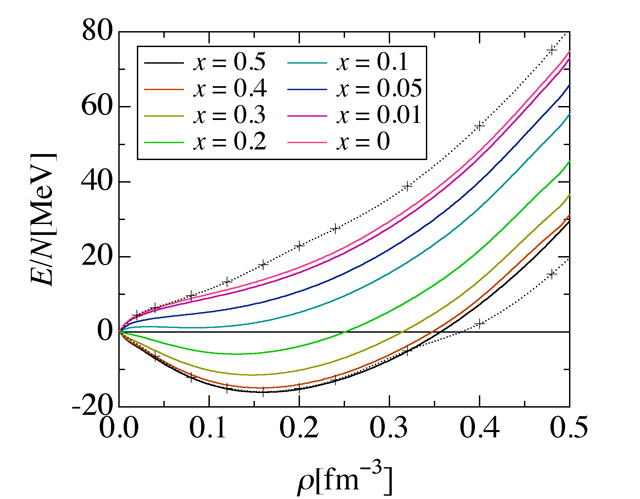
ページ読込中...

ページ読込中...

[English]
| 鷹野 正利 [教授・理工研] |  |
|
| 専門分野 | 原子核物理学 | |
| Homepage | https://www.np.phys.waseda.ac.jp/ | |
| 研究テーマ・研究活動 | ||
| ◯核物質状態方程式の研究と天体物理学への応用 ◯強い粒子間相関をもつFermi粒子系に対する変分法 |
||
| ●日本物理学会 ●アメリカ物理学会 |
||
原子核は核子(陽子と中性子)が核力という力で結合している系で、現在約3000種類の原子核が実験的に知られています。それらの膨大な実験データの多くについて、まだ理論的に十分な説明がなされていません。 原子核構造研究の困難さは2つの側面を持ちます。1つは、核力の複雑さです。核力は強い短距離引力と斥力芯から成り、また核子のスピンや速度等によって変化する、非常に複雑な力です。さらに、3つの核子の間に働く3体力も重要であると考えられています。 もう1つは、多体問題的側面です。一般に多体問題を解く事は困難ですが、例えば鉛の原子核208Pbは、82個の陽子と126個の中性子から成り、その構造を知るためには208体問題を解かなければなりません。現状で、これを厳密に解く事は不可能です。
そこで我々は、無限個の核子から成る無限に大きい仮想的な原子核(以下では核物質と呼びます)を考えます。そして、主に変分法を用いて、核物質の多体問題的研究を行う事により、核物質の観点から原子核の大局的性質を理解する事を目指します。 核物質エネルギーの理論計算により、いわゆる核物質の状態方程式(EOS)が得られます。計算された核物質EOSの信頼性を調べるために、我々は宇宙に目を向けます。
 「仮想的」な無限に大きい核物質は、中性子星という天体の姿で存在します。中性子星は超高密度の天体で、非常に強い自己重力に対して、内部核物質の硬さが星を支えています。よって、中性子星の構造研究には、核物質EOSの情報が必要です。また逆に、中性子星観測結果との比較で、計算された核物質EOSの信頼性が確認できます。(図は中性子星の半径と質量の関係を表します。)さらに、恒星の進化の最終段階で起こる超新星爆発のきっかけも、核物質の硬さにあると考えられ、そのような天体現象の理解には、核物質EOSの情報が不可欠です。 このように核物質EOSは、原子核物理学、天体物理学で重要な役割を果たしますが、これを実験的に決定する事は困難で、信頼性の高い理論多体計算が必要です。我々のグループでは、こうした中性子星、超新星爆発等の天体現象の理論的研究に適用可能な核物質EOSの研究を行っています。
「仮想的」な無限に大きい核物質は、中性子星という天体の姿で存在します。中性子星は超高密度の天体で、非常に強い自己重力に対して、内部核物質の硬さが星を支えています。よって、中性子星の構造研究には、核物質EOSの情報が必要です。また逆に、中性子星観測結果との比較で、計算された核物質EOSの信頼性が確認できます。(図は中性子星の半径と質量の関係を表します。)さらに、恒星の進化の最終段階で起こる超新星爆発のきっかけも、核物質の硬さにあると考えられ、そのような天体現象の理解には、核物質EOSの情報が不可欠です。 このように核物質EOSは、原子核物理学、天体物理学で重要な役割を果たしますが、これを実験的に決定する事は困難で、信頼性の高い理論多体計算が必要です。我々のグループでは、こうした中性子星、超新星爆発等の天体現象の理論的研究に適用可能な核物質EOSの研究を行っています。
| Masatoshi Takano [Professor] |  |
|
| homepage | https://www.np.phys.waseda.ac.jp/eng.html | |
| research field | Theoretical study of Nuclear Equation of State | |
| research keywords | ||
| Equation of state for nuclear matter Variational method Neutron stars Supernovae |
||
| link | ||
| Research Profiles (at Faculty of Science and Engineering)Research Profiles (Elsevier SciVal Experts) | ||
The atomic nucleus is a quantum-mechanical system composed of nucleons (protons and neutrons) interacting through nuclear and Coulomb forces. One of the fundamental properties of the atomic nucleus is the so-called “saturation property of nuclear forces,” i.e., that the nucleon number densities inside the nuclei and the binding energies per nucleon are nearly constant for all nuclei. In order to explain this basic property of the atomic nucleus quantitatively, the Schrodinger equation for the atomic nucleus must be solved. So far, however, this has not been achieved because the nuclear Hamiltonian, especially the potential of the nuclear force, has some uncertainty. More seriously, the quantum many-body problem is especially difficult to solve.
In order to overcome the latter difficulty, we have been studying the quantum variational many-body theory for infinitely-large fermion systems. The variational method is a powerful technique to treat the quantum systems in which the particles interact through strong short-range forces, such as infinite hypothetical nuclear matter and liquid helium. In the case of liquid 3He, the spin-1/2 3He atoms interact through intermolecular forces, and the Hamiltonian bears some resemblance to that of nuclear matter. Furthermore, the experimental data to be compared with the theoretical calculations for liquid 3He are more abundant than in the case of nuclear matter. Therefore, we are studying not only nuclear matter but also liquid 3He.
Infinitely-large nuclear matter can be found as neutron stars. A neutron star is a compact object whose mass is about twice the solar mass (or somewhat less), with the radius being about 10 kilometers. Inside the star is high-density nuclear matter. Against strong self-gravity, the stiffness of the interior nuclear matter supports the neutron star. Therefore, the neutron star structure is determined by the stiffness of the interior nuclear matter, or more generally, by the equation of state (EOS) of nuclear matter. Furthermore, owing to the recent development of neutron star observations, various constraints are imposed on the nuclear EOS. We are studying the neutron star structure in connection with the nuclear EOS obtained with our variational method.
The nuclear EOS is also important for studies of core-collapse supernovae and other high-energy astrophysical phenomena such as hypernovae, black-hole formations, and neutron star mergers. In order to study these astrophysical phenomena with numerical hydrodynamic simulations, the EOS of nuclear matter covering an extremely wide range of densities, temperatures, and proton fractions is necessary. We are constructing a new nuclear EOS appropriate for these astrophysical phenomena based on the variational many-body theory.
 Energies per nucleon of asymmetric nuclear matter at zero temperature E/N for various proton fractions x, as functions of the nucleon number density ρ. The AV18 and UIX potentials are employed for the two-body and three-body nuclear forces, respectively. The dotted curves with crosses are with the Fermi Hypernetted Chain calculation for x = 0 (upper one) and x = 0.5 (lower one) by Akmal et al. (PRC58[1998]1804).
Energies per nucleon of asymmetric nuclear matter at zero temperature E/N for various proton fractions x, as functions of the nucleon number density ρ. The AV18 and UIX potentials are employed for the two-body and three-body nuclear forces, respectively. The dotted curves with crosses are with the Fermi Hypernetted Chain calculation for x = 0 (upper one) and x = 0.5 (lower one) by Akmal et al. (PRC58[1998]1804).